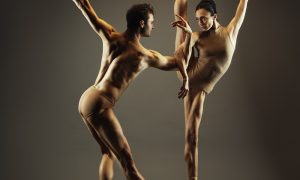Dance Informa considers how our cheers really affect our dancers.
If you’ve attended a number of dance competitions or recitals, at some point you have probably heard an adult cheer on a student dancer with “Werk it, girl!” or “Shake it!” Best-case scenario, the young dancer might have smiled and added a little more oomph to his/her routine – battementing his/her leg higher or landing his/her next jump stronger. Worst-case scenario, however, the student started strutting or shaking in a way that drew attention to his/her hips or chest in a way that felt more Rated R than PG.
It only takes one or two times witnessing a child or teen be praised or whistled at in this way that makes one begin to ask: Is there a wrong way to verbally cheer on young dancers? How do our cheers really affect our dancers?
Continuing our series seeking to address some of the harder questions affecting the industry, Dance Informa looks at this issue with the help of representatives from dance educator Leslie Scott’s non-profit organization Youth Protection Advocates in Dance (YPAD). While YPAD addresses more than just the appropriateness of cheers – it considers how everything from choreography, to dance costumes, to music choices, to teaching methods, to artistic concepts and more affect students in their seminars and certification programs. The organization is exceptionally mindful of how dancers are given verbal affirmation. As Scott points out, verbal affirmations have a powerful impact on children, especially when given in a public setting by a crowd, such as at conventions and competitions.
To consider this issue, let’s hear from three doctors and three studio owners who serve on YPAD’s Advisory Panel.
The psychology of the cheer
Dr. Christina Donaldson, a former dancer and a trained psychologist who has worked with adolescents for over 15 years, explains why verbal affirmations are so powerful to children and teen’s developing brains.
“In general, cheers/affirmations can be interpreted as reinforcement of a behavior or, in the case of dance, a movement,” Dr. Donaldson says. “In the field of psychology, we call this process ‘operant conditioning’. Operant conditioning is a learning process through which the strength of an individual behavior is modified by either a reward or a punishment. Typically, if something feels good (reward), we repeat the behavior, and when it doesn’t feel good (punishment), we avoid the behavior.”
She continues, “When we are experiencing a reward, chemicals (neurotransmitters) are released inside the brain that, in turn, provide us with a ‘feel good’ feeling. The most well-known neurotransmitters that are released when rewarded are dopamine and endorphins. Dopamine, in general, is termed as a pleasure stimulator, but it is thought to be more of a motivation stimulator, for it increases the individual’s motivation to repeat an action that is associated with a pleasurable feeling.”
Dr. Donaldson adds, “In dance competitions, sometimes children are praised for dancing/acting in a sexualized manner or on their looks. When a child is rewarded for dancing/acting in a sexualized manner, then they are motivated to continue that specific behavior in order to seek that ‘feel good’ feeling.”
As previously discussed in the column “What’s Wrong With Dancing Sexy?”, hyper-sexualization of children is dangerous in every form it takes on. As Dr. Donaldson explains, it goes back to conditioning. The meaning and tone of our cheers are an avenue of conditioning.
“We as human beings are biologically programmed to seek out pleasure and avoid pain,” she states. “Shouting out comments, inappropriate or appropriate, can be interpreted as a reward for the dancer. The deeper meaning is their sense of worth can get attached to their physical appearance (objectification) or in dancing provocatively (sexualizing), and they will continue to seek out those experiences throughout their life for validation.”
What we praise and how we praise
Dr. Steven Karageanes, DO, FAOASM is a distinguished primary care sports medicine specialist at St. Mary Mercy Hospital in Michigan. Previously contributing expertise to our column on the issue of artists dancing sick or injured, Dr. Karageanes is also the father of a competition dancer. Like Dr. Donaldson, he believes that positive and appropriate cheers can be great for dancers but is concerned for the inappropriate cheers students are often affirmed with instead. Beyond objectification and sexualization, he considers other problematic things that our verbal affirmations can convey.
“To be completely honest, most people cheer dancers on in competition in order to help them win awards,” he says. “Because these dance conventions include a competitive element, parents, friends and fans take sides. In competition, you have winners and losers, and nobody enjoys losing. Parents and friends can get caught up in the winning and forget to show sportsmanship and class toward other dancers and studios.”
When cheers are for the purpose of winning, they condition students to believe results are more important that the process, that the award is more life giving than the actual experience. So as Dr. Karageanes surmises, cheers can’t just be classified as negative when sexualized but when driven by awards-are-more-important-than-the-actual-dancing mentality.
In addition to what we praise, Dr. Karageanes also focuses on how we praise or, in some cases, actually teardown.
Dr. Karageanes adds, “Cheers coming from a negative intention should be avoided, like saying something when a competing dancer has a misstep, giving corrections during the piece or critiquing other dancers out loud (a very common occurrence).”
Real life experiences and data
For those in the dance industry who haven’t experienced or witnessed any harmful cheering methods toward student dancers, you may count yourself lucky. YPAD reports that it is a common conversation between representatives and trainees at seminars and certifications.
Vanessa Terrell, the owner and director of The Pointe School of Dance in Cedar Rapids, Iowa, shares how her studio sees young dancers inappropriately cheered on and awarded every competition season.
“Teachers and parents sometimes cheer loudest at sexualized moments in the music or choreography at competitions, which seems to really increase the energy level of the performers in those movements,” Terrell says. “Sometimes, we hear parents or teachers cheer ‘Werk it, girl!’ or ‘Shake it!’ when dancers are facing the back of the stage and twerking or shaking their hips.”
She adds, “I’d love to see applause and cheers in dance reserved for technical achievements – the clean pirouette, the effective formation change, the beautiful grande jeté – rather than the shocking or sexualized movements.”
She shares one example of inappropriate (and even dangerous) cheering that still stands out to her: “Several years ago, a soloist about age 12 was performing a jazz solo. When she landed from a leap, it looked like her ankle rolled. She continued to dance, although she was obviously limping on that foot and in pain. The audience got so quiet out of concern for this girl, and one woman (I’d assume either her mom or teacher) stood up and cheered, ‘Dance through it! Keep going! Don’t stop!’ over and over. I knew this dancer should stop, check out her ankle, take a rest and then figure out if she was okay to dance, but with the encouragement from these cheers, she finished her solo and limped off stage.”
This is an example of a cheer that reinforced the idea that public performance comes before personal health, as discussed here.
Tiffany Prout-Leito, who has owned and directed her Center Stage Dance Academy in Plymouth, and Sagamore Beach, Massachusetts, for 20 years, also reports “unfortunately” hearing the “werk it” cheer repeatedly during dance competitions.
“It is always screamed out during the most sexualized moves or only when a child does specific tricks,” she says. “What saddens me most is it is usually coming from the moms and dads of the dancers.”
YPAD Founder and Director Leslie Scott even recalls, “At a recent competition, the MC said after a hypersexualized performance by nine- to 10-year-olds, ‘Well, alright! Teach ’em young!’”
Dr. Tomi-Ann Roberts, PhD, professor and chair of the Psychology Department at Colorado College, shares a recent finding she reached with her students that exemplifies the current trends in the dance industry, possibly in response to years of inappropriate verbal affirmations and cheers for sexualized routines.
“We developed a coding system for sexualized appearance (e.g., skin showing) and sexualized movements (e.g., unbroken eye contact with camera, self-touch) and coded YouTube videos featuring youth dancers from top choreographers/studios – 18 total videos,” Dr. Roberts says. “We found that those videos with the most sexualized elements were the ones that had the most ‘views’ and ‘likes’ by miles. The average number of views for sexualized videos was 15 million, and the average number of views for non-sexualized videos from the same choreographers/studios was 50,000.”
Using and teaching the right kind of verbal affirmations
Along with the other representatives from the YPAD Advisory Panel, former studio owner Katie Gatlin, B.S., M.S., points out that an important way to help turn the tide on this issue of inappropriate cheers is to use and teach the right kind of verbal affirmations.
For during a performance, Gatlin advises, “When cheering, I would stick to the basics. ‘Way to go!’ or ‘Great energy!’ Shy away from comments regarding physical appearance or body performance. Simply clapping is also a great way to remain positive!”
Dr. Donaldson shares examples of healthy affirmations that can be given to a dancer pre- or post-performance:
– “I know you have worked so hard for this; you must feel so proud.”
– “I know you were really nervous to do this, and yet you did it! What courage!”
– “Yay, you!”
– “I am so proud of your efforts.”
– “I really like this particular part in the routine, for it looked like you were really feeling it.”
– “I liked when you did [insert movement], for it looked really difficult. You must have had to practice that a lot.”
Similarly, Dr. Karageanes says he tries to focus his affirmations on his daughter’s process and not on the result.
“Kids are smart; they know when you are just saying empty platitudes. (‘You rock, honey!’) So I try to see things like how she is moving, how much fun she is having, find specific things to affirm. This requires one to be more in tune with the dancer, and being busy at work, I am not always right there with my daughter. But my wife has the same mentality. So pointing out things like, ‘You really nailed those turns’ or ‘Your back walk-overs look really easy,’” he said.
Dr. Karageanes notes that it’s important to remember that different dancers respond to different affirmations.
Prout-Leito admits that she doesn’t really advocate for any cheering or yelling during a routine, as she thinks it takes away from the dance and the dancer.
“When you’re at a show or competition and you hear people screaming out, it distracts you and you’re naturally drawn to look at the screamers,” she says. “You would never go into a professional dance show and have the audience yelling during a dance. Applause and cheers were always reserved for after a dancer finished.”
Instead of advocating for positive cheers, Prout-Leito chooses to use competitions to teach her dancers theater etiquette.
Terrell, taking a different approach, combats inappropriate cheering by intentionally instructing her dancers on how to politely applaud for everyone. She tells them to feel free to cheer when they see something they love but not to feel like they have to cheer at competition when it seems like everyone else does. She’s teaching them how to gauge their own deeper response to routines.
“Our families often sit together in the audience at events, and they cheer loudly for some of the beautiful, artistic and entertaining pieces we see – presented by any studio – but they really believe in our mission to keep dance safe, healthy and positive for kids and don’t participate in cheering for the sexualized content,” she says. “Building this type of culture is hard work and we continue to work on this every week in classes, rehearsals and communication to our families. I’d be happy to talk with any studio owner or dance teacher looking to make this a part of their studio culture about how we’re working on this all the time!”
YPAD and Dance Informa agrees – it’s time for the industry to be more intentional about what, how and why we cheer! Let’s seek to end the era of unhealthy messaging for dancers and instead vow to be forces that only give out positive and healthy verbal affirmation toward students!
For more information on YPAD, visit www.ypad4change.org.
By Chelsea Thomas of Dance Informa.















